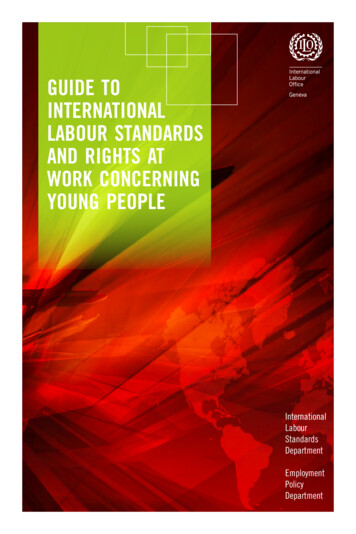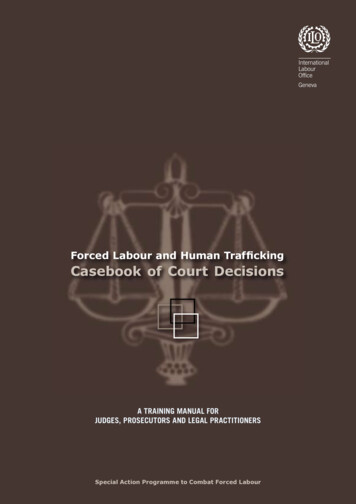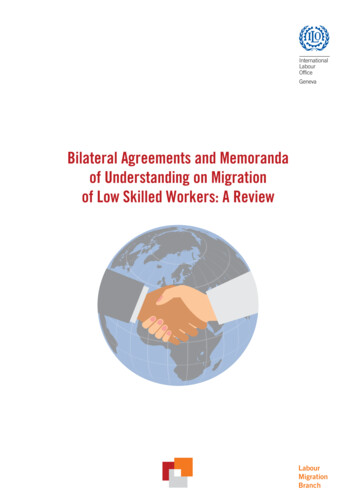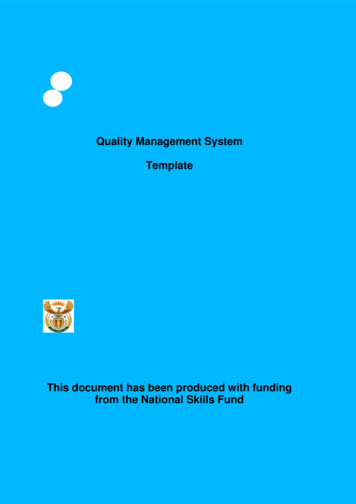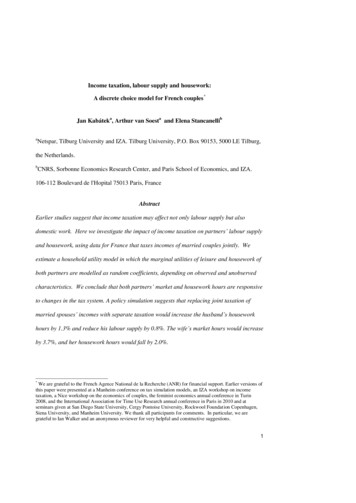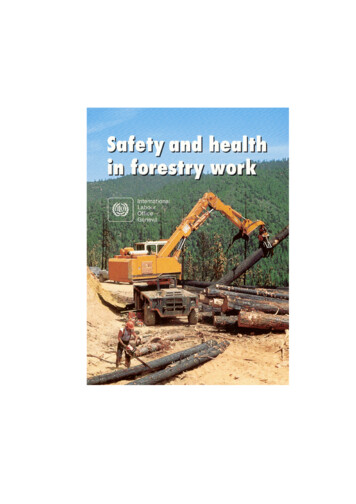
Transcription
The International Labour OrganizationThe International Labour Organization was founded in 1919 to promote social justice and, thereby, tocontribute to universal and lasting peace. Its tripartite structure is unique among agencies affiliated to the UnitedNations; the ILO's Governing Body includes representatives of government and of employers' and workers'organizations. These three constituencies are active participants in regional and other meetings sponsored by theILO, as well as in the International Labour Conference – a world forum which meets annually to discuss socialand labour questions.Over the years, the ILO has issued for adoption by member States a widely respected code of internationallabour Conventions and Recommendations on freedom of association, employment, social policy, conditions ofwork, social security, industrial relations and labour administration, among others.The ILO provides expert advice and technical assistance to member States through a network of offices andmultidisciplinary teams in over 40 countries. This assistance takes the form of labour rights and industrialrelations counselling, employment promotion, training in small business development, project management,advice on social security, workplace safety and working conditions, the compiling and dissemination of labourstatistics, and workers' education.ILO publicationsThe International Labour Office is the Organization's secretariat, research body and publishing house. ThePublications Bureau produces and distributes material on major social and economic trends. It publishespolicy statements on issues affecting labour around the world, reference works, technical guides, research-basedbooks and monographs, codes of practice on safety and health prepared by experts, and training and workers'education manuals. It also produces the International Labour Review in English, French and Spanish, whichpublishes the results of original research, perspectives on emerging issues, and book reviews.Catalogues and lists of new publications are available free of charge from ILO Publications, InternationalLabour Office, CH-1211 Geneva 22, Switzerland.
Safety and healthin forestry work
ILO code of practiceSafety and healthin forestry workInternational Labour OfficeGeneva
Copyright International Labour Organization 1998First published 1998Publications of the International Labour Office enjoy copyright under Protocol 2 of the UniversalCopyright Convention. Nevertheless, short excerpts from them may be reproduced without authorization,on condition that the source is indicated. For rights of reproduction or translation, application should bemade to the Publications Bureau (Rights and Permissions), International Labour Office, CH-1211 Geneva22, Switzerland. The International Labour Office welcomes such applications.Libraries, institutions and other users registered in the United Kingdom with the Copyright LicensingAgency, 90 Tottenham Court Road, London W1P 9HE (Fax: 44 171 436 3986), in the United States withthe Copyright Clearance Center, 222 Rosewood Drive, Danvers, MA 01923 (Fax: 1 508 750 4470), or inother countries with associated Reproduction Rights Organizations, may make photocopies in accordancewith the licences issued to them for this purpose.ILOSafety and health in forestry work: An ILO code of practiceGeneva, International Labour Office, 1998/Code of practice/, /Occupational safety/, /Occupational health/, /Forestry/. 13.04.2ISBN 92-2-110826-0Also published in French: Sécurité et santé dans les travaux forestiers: Recueil de directivespratiques du BIT, and Spanish: Seguridad y salud en el trabajo forestal: Repertorio derecomendaciones prácticas de la OIT.ILO Cataloguing in Publication DataThe designations employed in ILO publications, which are in conformity with United Nations practice,and the presentation of material therein do not imply the expression of any opinion whatsoever on the partof the International Labour Office concerning the legal status of any country, area or territory or of itsauthorities, or concerning the delimitation of its frontiers.The responsibility for opinions expressed in signed articles, studies and other contributions rests solelywith their authors, and publication does not constitute an endorsement by the International Labour Officeof the opinions expressed in them.Reference to names of firms and commercial products and processes does not imply their endorsement bythe International Labour Office, and any failure to mention a particular firm, commercial product orprocess is not a sign of disapproval.ILO publications can be obtained through major booksellers or ILO local offices in many countries, ordirect from ILO Publications, International Labour Office, CH-1211 Geneva 22, Switzerland. Cataloguesor lists of new publications are available free of charge from the above address.Printed in SwitzerlandATA
PrefaceForestry continues to be one of the most hazardous industrial sectors in mostcountries. Around the world, there are often discouraging trends of rising accidentrates and a high incidence of occupational diseases and of early retirement amongforestry workers. However, clear evidence shows that good safety and healthperformance in forestry is feasible. Many ILO constituents recognize that safety atwork is not only an ethical imperative, but that it makes "dollars and sense". Inforestry, it is also a prerequisite for environmentally sound management andutilization of natural resources. Significantly, these governments, enterprises,employers' and workers' organizations are willing to do something about it.This code is not a legally binding instrument intended to supersede nationallegislation. It has been designed to provide guidance to ILO constituents in theirendeavour to improve the safety and health performance of their national forestrysectors or enterprises. The code is based on state-of-the-art internationalexperience, and is intended to be relevant and practicable in most countries andenterprises. It aims to protect workers from hazards in forestry work and to preventor reduce the incidence of occupational illness or injury. It contains useful ideaseven for countries and enterprises with well-developed prevention strategies, but isespecially valuable for those that lack relevant regulations and guidelines.The present code of practice was drawn up by a meeting of experts from majortimber-producing countries, held in Geneva from 23 to 30 September 1997. Inaccordance with a decision of the ILO's Governing Body at its 265th Session(March 1996), the meeting was composed of 30 experts, ten followingconsultations with governments, ten following consultations with the Employers'group and ten following consultations with the Workers' group of the GoverningBody1.1Experts nominated by governments:Mr. André Luiz Cardoso Morais, Coordinator for Inspection and Standardization, Office forOccupational Safety and Health, Ministry of Labour, Brasilia (Brazil).Mr. Clay Perry, Consultant, Government of Canada, Vancouver, British Columbia (Canada).Mr. Manuel Parra Garrido, Chief of the Working Conditions and Environment Unit, Labour Office,Inspection Department, Santiago (Chile).Mr. Josef Bozovsky, Official, Labour Inspectorate for South Bohemia, Ceske Budejovice (CzechRepublic).Mr. Bernard Obiang Ossoubita, Inspector-General of Occupational Health and Medicine, Ministry ofLabour, Employment and Vocational Training, Libreville (Gabon).Mr. Musri Mohtar, Deputy Director, Department of Occupational Safety and Health Malaysia, KualaLumpur (Malaysia).Adviser:Mr. Azlan Yusof, Counsellor for Labour Affairs, Permanent Mission of Malaysia, Geneva,Switzerland.Mr. Bernard Collings, Forestry Officer, Department of Labour, Whangarei, North Island (NewZealand).V
Safety and health in forestry workMr. Samuel F. Van Greunen, Deputy Director of Occupational Health and Safety, Department of Labour,Witbank, Mpumalanga (South Africa).Mr. Albert Johansson, Head of Division, National Board of Occupational Safety and Health, Solna(Sweden).Mr. Richard Terrill, Regional Administrator, Occupational Safety and Health Administration, UnitedStates Department of Labor, Seattle, Washington (United States).Experts nominated by the employers:Mr. Bruce Alt, Division Forester, American Pulpwood Association, Clinton, Mississippi (UnitedStates).Mr. Michael Astier, Social Affairs Officer, Federation nationale du bois, Paris (France).Mr. Len K. Evans, Workplace Safety and Industrial Relations Manager, North Forest Products,Launceston, Tasmania (Australia).Mr. João Batista Garnica, Chief of Operational Development, Bahia Sul Celulose S.A., Bairro MonteCastelo, Bahia (Brazil).Mr. Felipe Gayoso Pabón, Legal Adviser, Asociación Agraria – Jóvenes Agricultores, Seville(Spain).Mr. Eric Mitterndorfer, President, Pulp and Paper Employee Relations Forum, Vancouver, BritishColumbia (Canada).Mr. Muhammad Abdul Karim, Forestry Manager, Amanah Saham Pahang Berhad, Kuantan PahangDarul Makmur (Malaysia)Mr. Juhani P. V. Pöllänen, Labour Market and Social Affairs Specialist, Finnish Forest IndustriesFederation, Helsinki (Finland).Mr. Adamson Stephen Tong'o, Chief Executive, Viphya Plywoods and Allied Industries Ltd.,Chikangawa, Mzimba (Malawi).Ms. Magdalena Uribe Rivas, Director, Chamber for Pulp, Paper and Board, National Association ofIndustry, Santa Fe de Bogotá (Colombia).Experts nominated by the workers:Mr. Mohd Khalid B. Atan, General Secretary, Timber Employees' Union of Peninsular Malaysia,Ampang, Ulu Klang, Kuala Lumpur (Malaysia).Ms. Pirkko Heikura, Representative, Wood and Allied Workers' Union, Helsinki (Finland).Mr. Inge Johansson, Environment Official, Swedish Forestry Workers' Union, Gävle (Sweden).Mr. Jiri Kucera, Representative, Wood, Forestry and Water Industries Workers' Trade Union, Prague(Czech Republic).Mr. Chris Northover, Senior Assistant Secretary, Forest Products Division, Construction ForestryMining Energy Union, Charlton South, Victoria (Australia).Mr. Valery Ochekurov, President, Timber and Related Industries Workers' Union, Moscow (RussianFederation).Ms.Mr.Ms.Mr.VIAdvisers:Mr. Oleg Gutorenko, Federal Secretary, Timber and Related Industries Workers' Union,Moscow (Russian Federation).Mr. Iouri Gouchtchine, Regional President, Timber and Related Industries Workers' Union, St.Petersburg (Russian Federation).Mr. Alexander Voznessensky, Vice-President, Timber and Related Industries Workers' Union,Moscow (Russian Federation).Eva-Maria Pfeil, Industry Specialist, Construction, Agriculture and Environment IndustrialUnion (IG-BAU), Frankfurt am Main (Germany).Jaime E. Quirós Guevara, National Federation of Building and Wood Workers(FENATRACOMAP), Panama City (Panama).Paula Ross, Business Representative, International Association of Machinists, Shelton,Washington (United States).Lawrence Turkson, National Executive Committee Member, General Agricultural Workers'Union, Forestry Research Institute of Ghana, Kumasi (Ghana).
PrefaceThe meeting of experts unanimously adopted the text of this code, which wasapproved for publication by the Governing Body at its 270th Session (November1997). Important features are that:The code covers all types of forestry workers, including groups with aboveaverage accident statistics, such as contractors, the self-employed and forestfarmers.Safety is not an afterthought and it cannot be retrofitted. Therefore, the codedoes not focus on technical measures and safe performance, but emphasizes thatsafety starts at the top – at the national level, in the enterprise and at theworksite.It outlines a safety management system for enterprises that integrates safety intooverall enterprise management.It provides for training and skill certification as key conditions for safety inforestry.It offers detailed technical guidance on logging and on some high-riskoperations like tree climbing, harvesting of windfall and forest fire-fighting.This guidance is intended to help countries and companies that have no forestryspecific regulations.Intergovernmental organizations represented:Arab Labour Organization: Mr. Adnan El-Telawi.Food and Agriculture Organization of the United Nations (FAO): Mr. Joachim Lorbach.Non-governmental organizations represented:Federation of Timber and Related Industries Workers' Union of the Commonwealth of IndependentStates:Mr. Victor Karniushin, President, Federation of Timber and Related Industries Workers' Unionof the Commonwealth of Independent States, Moscow, Russian Federation.Mr. Roman Goronovsky, President, Timber Workers' Union of Bielorussia, Minsk, Belarus.Mr. Karibai Assankhodzaev, President, Union of Timber and Related Industries Workers ofKyrgyzstan, Bishkek, Kyrgyzstan.Ms. Marina Mussiniants, International Section Officer, Federation of Timber and RelatedIndustries Workers' Union of the Commonwealth of Independent States, Moscow, RussianFederation.Ms. Londa Sikharulidze, President, Timber, Paper and Wood Workers' Union of Georgia,Tbilisi, Georgia.International Confederation of Free Trade Unions (ICFTU).International Cooperative Alliance (ICA).International Federation of Building and Woodworkers.International Organization of Employers.ILO representatives:Mr. V. Morozov, Director, Sectoral Activities Department.Mr. B. K. Nilssen, Chief, Industrial Activities Branch.Mr. P. Poschen, Industrial Activities Branch.Mr. P. Blombäck, Industrial Activities Branch.Ms. M. J. Canonica-Marques, Multisectoral Support Section.VII
Safety and health in forestry work This code applies to:all organizations, whether legislative or advisory, whose activities influence thesafety, health and welfare of those engaged in forestry work;employers, those in control of premises, workers, service contractors and selfemployed people, as appropriate to their duties and responsibilities for safetyand health;all forestry activities.It may also be useful for landscape gardeners and others involved in workrelating to trees that are not in forests.Ideally, tripartite committees should adapt the code to circumstances in acountry or enterprise, and integrate its provisions into overall codes of forestrypractice that cover all performance requirements for forestry operations, includingproductivity, environmental concerns and safety. The ILO is actively promoting thedevelopment of such national codes. It is ready to provide advice and technicalassistance to its constituents on training, on the formulation of national codes, or onany other aspect concerning this code of practice.Requests for further information or assistance may be directed to:The Forestry and Wood Industries SpecialistIndustrial Activities BranchInternational Labour Office1211 Geneva 22Switzerlandtel.: 41 22 799 7475; fax: 41 22 799 7967e-mail: sector@ilo.org .VIII
ContentsPreface .VObjective. 1Scope and application . 3Definitions . 5Part I. General principles, legal framework and general duties . 91. Gener al principles . 92. Le gal fr amework and gen eral duties . 11Legal framework and duties of competent authorities .11Duties of labour inspectorates .13Responsibilities and duties of employers .14Duties of managers and supervisors.18Responsibilities and duties of contractors.19Rights and responsibilities of workers .19Duties of manufacturers and suppliers of equipment and substances.20Part II. Framework for safety and health at the enterprise level. 233. Enterprise safety and health policy . 2 34. Safet y and he alth mana gement . 25Assignment of responsibility.25Identification and management of risks .25Organization of personnel .26Provision of resources .26Communication and information .27Documentation .27Pa r t III. Gene ral requ ir e m e nt s . 295. W orkforce . 29Employment conditions .29Qualifications of managers, supervisors and operatives .30Qualifications of managers and supervisors.30Training and skills testing for operatives .30Qualifications of contractors .316. Safet y requir ements for tools, machines a ndhaz ardous chemic als . 32General requirements .32Hand tools .33Machinery, portable .33Machinery, self-propelled or activated by prime mover.34Winches and chokers.35Cable cranes .357. W ork clothing and pe rsonal prote ctive equipment . 36General provisions .36Personal protective equipment appropriate for forestry operations .36IX
Safety and health in forestry work8. Testing and certifi cation of equipment . 39General provisions.39Testing procedures and criteria .39Certification.399. Fi rst aid, emer genc y rescu e and oc cupational he althservices . 40First aid.40Rescue .40Occupational health services .41Medical care .411 0. Shelters, housing and nutr ition . 42Shelters and housing.42Nutrition and drinking water .421 1. R eporting, r ecordin g, notif ic a tion a nd inve stiga tion ofoccupational a ccidents and dise ases . 44General provisions.44Occurrences subject to reporting and notification.44Practice of reporting, recording, notification and investigation.44Part IV.Technical guidelines for safety and health at the forestry worksite. 471 2. G ener al provisions . 47Planning and organization of forestry work .47Site inspection and planning.48Work organization.48Protection from unfavourable weather conditions and biologicalhazards.5013. Silviculture . 51Site preparation.51Manual clearing .51Site preparation with hand-held machines.52Mechanized site preparation .54Planting.54Organization .54Planting of untreated plants .55Handling and planting of chemically treated plants .55Planting by hand-held power post-hole borer (rock drill) .57Tending.57Pruning .58Organization .58Equipment.58Operation .5914. Harvestin g . 60General provisions.60Felling and conversion .61Manual and chain-saw felling.61Taking down cut-up or hung-up trees.68Manual and chain-saw debranching .71X
ContentsManual and chain-saw crosscutting.72Mechanized felling and conversion.72Extraction .76General provisions.76Manual extraction.77Extraction by chute.78Extraction with draught animals.78Extraction by skidder and winch .79Extraction by forwarder.81Extraction by cable crane .83Extraction by helicopter .84Landing and stacking.86Loading and transport .87Loading.87Road transport .88Water transport .8915. H igh- risk oper a tions . 9 0Tree climbing .90Organization .90Personnel .90Equipment .91Operation .92Clearance of windblow .94Organization .94Equipment .95Operation .95Fire-fighting .97Organization .97Personnel .98Equipment .98Operation .99Glossary of technical terms. 101References and further reading . 105R elevant publications . 10 5Relevant international labour stand ards . 106Relevant In tern ational Or ganiz ation for Standa rdiz ation( ISO ) standa rd s . 10 7Relevant Europe an standards . 109Other rel evant international classifications . 109Index. 111XI
Objective1. The objective of this code is to protect workers from occupational safetyand health hazards in forestry work and to prevent or reduce the incidence ofillness or injury by providing practical guidelines on:(a) the key components of safety policies and procedures at national, enterpriseand worker levels as an effective means of communicating minimumrequirements to all persons concerned, and as an aid to the planning andorganization of work;(b) the establishment of a framework for consultation and cooperation on safety,health and welfare involving those who create the risks, those who aresubsequently exposed to these risks and those bodies which are responsible forinspection and enforcement of regulations and standards;(c) basic requirements governing the execution of forest operations so that risk ofinjury or ill health is minimized;(d) a system for recording, reporting and monitoring occupational accidents anddiseases and dangerous occurrences which may be used to measure compliancewith requirements and/or the effectiveness of steps already taken to enhancethe status of safety and health;(e) a framework for the allocation of responsibility among the variousorganizations and individuals which collectively contribute to a positiveattitude to safety and health, and which ensure that safety and health haveequal ranking with other operational goals and considerations.1
Scope and application2. This code applies to:(a) all those organizations, whether legislative or advisory, whose activitiesinfluence the safety, health and welfare of persons engaged in forestry work, asappropriate to their function;(b) all those individuals at the level of the enterprise or undertaking, i.e.employers, persons in control of premises, workers, service contractors andself-employed persons, as appropriate to their duties and responsibilities forsafety and health;(c) all forestry activities, including the establishment and regeneration of forests,silvicultural work and forest protection, timber harvesting and transportation.3. The provisions of this code should be considered as minimumrequirements and are not intended to replace applicable laws, regulations oraccepted standards laying down higher requirements. More stringent applicablerequirements should have priority over the provisions in this code.4. The protection of workers in radioactively contaminated worksites is animportant issue beyond the scope of this code. Scientific expertise on safety andhealth practice is currently limited and should be encouraged so that adequateprotection standards can be developed. Forest workers should obtain properinformation regarding radioactive contamination in affected forest areas, and theyshould be supplied with and wear appropriate personal protective equipment, andbe provided with dosimeters. Managers and supervisors should endeavour to reducepossible risks and hazards to workers. Special personal hygiene facilities fordisactivation and treatment of personal protective equipment and tools should beavailable at the worksite, and regular medi
V Preface Forestry continues to be one of the most hazardous industrial sectors in most countries. Around the world, there are often discouraging trends of rising accident

